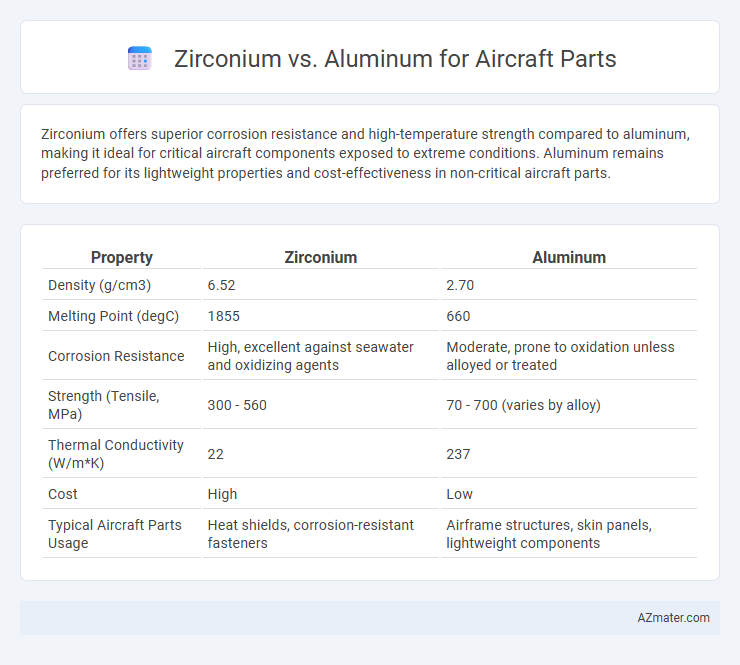Zirconium offers superior corrosion resistance and high-temperature strength compared to aluminum, making it ideal for critical aircraft components exposed to extreme conditions. Aluminum remains preferred for its lightweight properties and cost-effectiveness in non-critical aircraft parts.
Table of Comparison
| Property | Zirconium | Aluminum |
|---|---|---|
| Density (g/cm3) | 6.52 | 2.70 |
| Melting Point (degC) | 1855 | 660 |
| Corrosion Resistance | High, excellent against seawater and oxidizing agents | Moderate, prone to oxidation unless alloyed or treated |
| Strength (Tensile, MPa) | 300 - 560 | 70 - 700 (varies by alloy) |
| Thermal Conductivity (W/m*K) | 22 | 237 |
| Cost | High | Low |
| Typical Aircraft Parts Usage | Heat shields, corrosion-resistant fasteners | Airframe structures, skin panels, lightweight components |
Introduction to Zirconium and Aluminum in Aviation
Zirconium and aluminum serve distinct roles in aviation due to their unique properties; zirconium offers exceptional corrosion resistance and high strength at elevated temperatures, making it suitable for critical aircraft components such as engine parts and heat shields. Aluminum remains the primary choice in aircraft structures because of its lightweight nature, high strength-to-weight ratio, and excellent machinability, which contribute to fuel efficiency and overall performance. The strategic combination of zirconium's thermal durability and aluminum's structural versatility enables advanced aircraft designs optimized for both safety and efficiency.
Material Properties Comparison: Zirconium vs Aluminum
Zirconium exhibits superior corrosion resistance and higher melting points compared to aluminum, making it ideal for components exposed to extreme temperatures and harsh environments in aircraft. Aluminum offers a lightweight structure with excellent strength-to-weight ratio and good corrosion resistance, advantageous for reducing overall aircraft weight and improving fuel efficiency. While zirconium's density is higher than aluminum's, its exceptional fatigue resistance and thermal stability enhance durability in critical aircraft parts requiring long-term performance.
Weight Considerations for Aircraft Components
Zirconium offers a higher density than aluminum, making it heavier but more durable in critical aircraft components requiring corrosion resistance. Aluminum is widely favored for its lightweight properties, significantly reducing overall aircraft weight and improving fuel efficiency. Weight considerations prioritize aluminum for structural parts where minimizing mass is crucial while zirconium is selected for specialized components with stringent durability requirements.
Corrosion Resistance in Aviation Environments
Zirconium exhibits superior corrosion resistance compared to aluminum in aviation environments due to its stable oxide layer that protects against oxidation, salt spray, and high humidity. Aluminum alloys, while lightweight and cost-effective, are more prone to pitting and stress corrosion cracking under prolonged exposure to chlorides and saline conditions. The enhanced durability of zirconium alloys contributes to longer service life and reduced maintenance in aircraft parts exposed to harsh atmospheric conditions.
Strength and Durability Performance
Zirconium offers superior corrosion resistance and high strength-to-weight ratio compared to aluminum, making it ideal for aircraft parts subjected to extreme stress and high temperatures. Aluminum is lightweight with good strength but tends to degrade faster under harsh environmental conditions, limiting its durability in critical aircraft components. The enhanced fatigue resistance and overall longevity of zirconium alloys provide significant advantages in aerospace applications where reliability and performance are paramount.
Thermal Conductivity and Heat Resistance
Zirconium exhibits superior heat resistance compared to aluminum, maintaining structural integrity at temperatures exceeding 900degC, which makes it ideal for high-temperature aircraft components. Aluminum offers significantly higher thermal conductivity, around 205 W/m*K, facilitating rapid heat dissipation but with a melting point near 660degC, limiting its use in extreme heat conditions. The choice between zirconium and aluminum hinges on balancing aluminum's efficient heat transfer capabilities against zirconium's ability to withstand elevated temperatures without degradation.
Cost Analysis and Economic Impact
Zirconium offers superior corrosion resistance and strength-to-weight ratio compared to aluminum, but its significantly higher raw material and processing costs increase initial expenditures for aircraft parts manufacturing. Aluminum's abundance and ease of fabrication translate to lower production costs and widespread use, making it the more economical choice for large-scale applications despite slightly lower performance metrics. Cost analysis reveals that while zirconium components enhance durability and reduce maintenance expenses, the overall economic impact favors aluminum due to budget constraints and scalability in the aerospace industry.
Manufacturing and Fabrication Challenges
Zirconium offers superior corrosion resistance and high-temperature stability compared to aluminum, but its manufacturing challenges include difficulty in machining due to its hardness and reactivity, requiring specialized tools and controlled atmospheres. Aluminum, favored for its lightweight and ease of fabrication, presents fewer issues in casting, welding, and forming processes, though it lacks the high-temperature resilience of zirconium. The high cost and complex processing techniques for zirconium complicate large-scale fabrication, limiting its widespread use in aircraft parts despite performance advantages.
Common Applications in Aircraft Parts
Zirconium is primarily used in aircraft parts requiring high corrosion resistance and superior strength at elevated temperatures, such as turbine blades and engine components. Aluminum's common applications include airframes, fuselages, and wing structures, valued for its lightweight and excellent machinability. Both metals serve critical roles in aircraft manufacturing, with zirconium preferred for thermal stability and aluminum favored for weight reduction.
Future Trends and Technological Innovations
Zirconium alloys are emerging as a high-performance alternative to aluminum in aircraft parts due to their superior corrosion resistance, high strength-to-weight ratio, and excellent fatigue properties, which align with the aerospace industry's push for materials that enhance fuel efficiency and durability. Advances in additive manufacturing and surface treatment technologies are accelerating the adoption of zirconium, enabling more complex component designs and improved thermal stability compared to traditional aluminum alloys. Future trends indicate an increased hybridization of zirconium with aluminum composites to leverage the strengths of both metals, optimizing aircraft performance while reducing maintenance costs and environmental impact.

Infographic: Zirconium vs Aluminum for Aircraft Part
 azmater.com
azmater.com